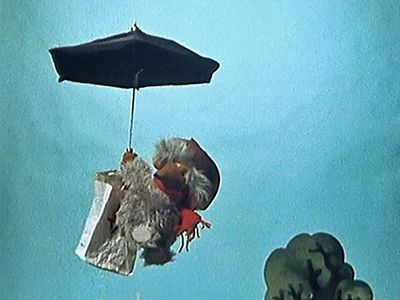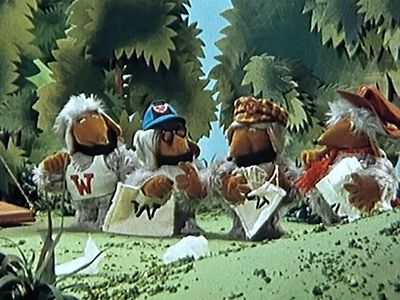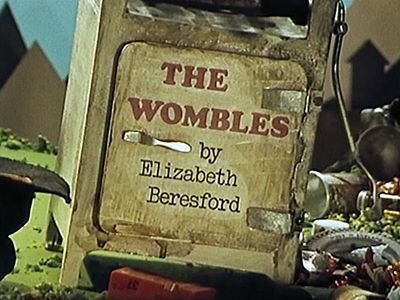Common vision: 50 years of The Wombles on TV

It’s 50 years since The Wombles first appeared on our TV screens in stop-motion animation, starting on 5 February 1973 at 5.40pm on BBC1.
The original book was published in 1968, and some of the stories were read on Jackanory in 1969 and 1971, which led to a full TV series being commissioned.
The very first TV episode was Orinoco And The Big Black Umbrella, which introduced the main characters and told the story of a windy day on Wimbledon Common (much simplified from the corresponding book chapter).
“This is the home of the Wombles,” it began, with a shot of the burrow door opening. “Tomsk, Wellington and Bungo are ready to start work. And here’s Great Uncle Bulgaria. But there’s someone missing. ‘Where is Orinoco?’ There he is, late as usual… ‘Sorry, I was just having an extra forty winks.’”
Bernard Cribbins narrated the five-minute episodes and gave all the Wombles their individual voices and personalities. Many people now know him best for The Wombles, but he’d already had a 30-year acting career by then, beginning in theatre aged 14.
In an interview at the BFI in 2010, Bernard Cribbins talked about how he recorded the programmes with lots of ad-libbing: “Elisabeth Beresford used to write a very minimal script, the lines for the characters obviously. And then the films were shot, and it was very laborious stop-frame animation - it took something like ten days to do the five minutes or whatever. And then I would get the finished article, have a look at it, and all the gaps I used to fill in with coughs and sniffs and wheezes and all sorts of stuff.”
Sadly Bernard Cribbins died last year, at the age of 93. He’d never retired, and had just filmed scenes for a return to Doctor Who in the 60th anniversary specials that will air in November 2023.
The distinctive look of the Wombles was created by director and animator Ivor Wood, who had already worked on The Magic Roundabout and later made Paddington and Postman Pat for television. The Wombles’ pointy-nosed, shaggy grey design was quite a change from the bear-like illustrations in the original books, but was adopted as the definitive style for later editions.

Author Elisabeth Beresford told The Times in a 2007 interview: “Monica Sims, who was the head of children’s programming at the BBC, said, after looking at the original books, ‘Elisabeth, we don’t think that’s what a Womble looks like’. So they employed a marvellous puppeteer called Ivor Wood. For his first few attempts Monica would say to him, ‘No, Ivor, we don’t think that’s what a Womble looks like’, and I would have to keep taking him for a drink to keep his spirits up. One day she said, ‘Well done, Ivor, you’ve got it right’.”
Ivor Wood told the Radio Times in 1973: “Preparation has taken us a whole year, which might seem a lot, but you have to remember that it entails endless discussions about the background decor and so on, not to mention all the work on the Womble characters themselves - particularly after the initial decision that they shouldn’t look too teddy-bearish. One has to live partly with the Wombles to be able to bring them to life, and as they are very human little characters you can get quite fond of them for their failings.”
Graham Clutterbuck, who founded FilmFair with Ivor Wood, told Animator magazine in 1988: “We were one of the top British production companies. A creative whizzkid called Terry Flanders came to me with an idea for an animated film series based on a book called The Wombles. That changed our lives in that Ivor Wood and I worked on the series for a long time. The BBC took it and, in today’s real terms, it was the biggest merchandising bonanza this country has known. When The Wombles was first shown on TV it had a cult following among people of all ages because it came on just before the evening news. It was seen by an estimated five to six million people. With that many viewers the sale of merchandising could not fail. But the BBC stopped that slot some years ago.”
Animator Barry Leith told Animator’s Newsletter in 1982: “On the first series of The Wombles I was just the model maker. Ivor saw a couple of little models I made, and I ended up getting a job helping him develop the Wombles, and I’ve been here [at FilmFair] ever since.” Comparing The Wombles to Paddington, he said: “In one sense it was nicer when we were doing the Wombles because there were seven of them. When you’ve got seven characters to play around with, you can get a lot more fun out of them, make individual characters, do all sorts of little cameos.”

On the title screen of the first series, Elisabeth Beresford was wrongly credited as ‘Elizabeth Beresford’ with a Z; this was corrected in series two in 1975. She was paid £50 an episode for the first series, and then £75 an episode for the second series, according to BBC News. But at their peak in the mid-Seventies, the Wombles were generating an estimated £17million a year.
One of the most memorable aspects of the TV series is its theme tune, The Wombling Song (often known as ‘Underground Overground’), which led to composer Mike Batt’s success with The Wombles as a pop group. In fact, it was Mike Batt who made up the verb ‘wombling’, which didn’t appear in the books. He told The Telegraph: “I suggested that instead of a theme tune they should have a song so the children could get to know the characters, and instead of my fee, which was about £200, I asked for the character rights, which enabled me to form the Wombles band.” With the help of an Orinoco costume made by his mother, he eventually got a record deal, and the rest is history.
So what’s the future? After ambitious plans to revive the Wombles with a new CGI television series, Mike Batt’s company Dramatico Animation ran into financial difficulties which resulted in him abandoning production and selling his rights. The new rights holder relaunched the Wombles in 2020 with new-look CGI characters, and has so far focused on building their profile with environmental messages and partnerships, while a new series of scripts is under development.
The Wombles’ adventures on the famous common have been enchanting viewers for half a century, and hopefully they’ll continue to educate and entertain future generations.
- This article was originally published in 2013 for the 40th anniversary, and has been slightly updated
- You might like Common origins: 50 years since the first Wombles book was published
- Radio Times: Underground, overground, Wombling free at 50! It’s a big birthday for TV’s eco-minded heroes
- Mirror Online: The Wombles celebrate 50th anniversary with remastered version of original episodes
- Londonist: The Wombles turn 50 years old this weekend
- London Post: The Wombles celebrate their 50th anniversary
- Yahoo! News: Son of The Wombles creator talks of expanding global legacy on 50th anniversary
- BBC News (audio): TV show The Wombles celebrates 50 years
